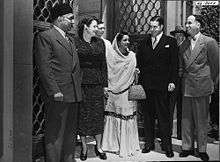Gharara
A gharara (Urdu: غرارہ, Hindi: ग़रारा, Bengali: ঘারারা) is a traditional Lucknowi outfit,[1] traditionally worn by Muslim women of the Indian subcontinent, notably Hindi Belt of modern-day India.[2] It consists of a kurti (a short, mid-thigh length tunic), a dupatta (veil), and most importantly, a pair of wide-legged pants, ruched at the knee so they flare out dramatically known as Gharara. The knee area, called the gota in Urdu, is often elaborately embroidered in zari and zardozi work. Each leg of a traditional gharara is made from over 12 metres of fabric, often silk brocade.[3]

Shararas originated in Awadh region of Uttar Pradesh during the era of the Nawabs.[2] During the late 19th and early 20th centuries, the gharara was part of the everyday attire among Muslim women of the Hindi Belt. Ghararas were also made popular in Pakistan and Bangladesh, in the 1950s and 1960s with popular public figures like Fatima Jinnah and Begum Rana Liaquat Ali Khan wearing them.
Although they are no longer worn as an everyday garment, they remain popular as wedding attire among Muslim women of the Hindi Belt and also among Urdu-speaking immigrants in Pakistan and Bangladesh.
Images
 Lucknow women in Gharara.
Lucknow women in Gharara. Lucknow Women in Gharara.
Lucknow Women in Gharara. Women in Gharara.
Women in Gharara. Women in Gharara.
Women in Gharara. Women in Gharara.
Women in Gharara. Girl in Gharara.
Girl in Gharara. Lucknow wedding.
Lucknow wedding. Women in Gharara.
Women in Gharara.- Lucknow singer in Gharara.
See also
References
- Naveen Patnaik (1985). A second paradise: Indian courtly life, 1590-1947. Doubleday. ISBN 9780385199926. Retrieved 13 November 2010.
Gharara lucknow.
- Yojana: Volume 6, Issue 20. Publications Division, Ministry of Information and Broadcasting. 1962. Retrieved 13 November 2010.
The Begums of Lucknow use a modification of ghagra, called gharara or bara paincha, which sometimes require 36 yards of cloth.
- Handcrafting a Culture